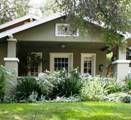
Bungalow (1905 – 1930s)
California Bungalows, Craftsman Bungalows, and Chicago Bungalows were variations of an affordable housing type that swept across America.
History:
The Bungalow is an all American housing type, but it has its roots in India. In the province of Bengal, single-family homes were called bangla or bangala. British colonists adapted these one-story thatch-roofed huts to use as summer homes. The space-efficient floor plan of bungalow houses may have also been inspired by army tents and rural English cottages. The idea was to cluster the kitchen, dining area, bedrooms, and bathroom around a central living area.
The first American house to be called a bungalow was designed in 1879 by William Gibbons Preston. Built at Monument Beach on Cape Cod, Massachusetts, the two-story house had the informal air of resort architecture. However, this house was much larger and more elaborate than the homes we think of when we use the term Bungalow.
Bungalow houses may reflect different architectural styles, such as Craftsman Bungalow, California Bungalow, Spanish Colonial Revival Bungalow, Dutch Colonial Revival Bungalow, etc.
Features:
One and a half stories
Most of the living spaces on the ground floor
Low-pitched roof and horizontal shape
Living room at the center
Connecting rooms without hallways
Efficient floor plan
Built-in cabinets, shelves, and seats
Next: Pueblo revival